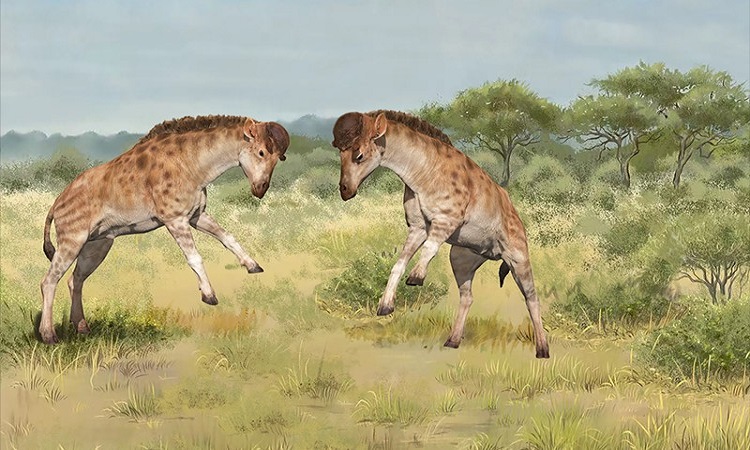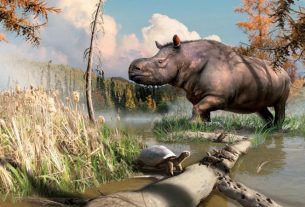About seventeen million years ago, a Short, stockier relative of modern giraffes roamed northern China. His skull was fitted with a thick keratin “helmet” probably used in clashes with rival males for sexual competition. Details of the study are published in the journal Science.
A thick neck, a helmeted head
Say hello to Discokeryx xiezhi. Fossils of this newly described species were discovered in the Junggar Basin, a large sediment-filled depression in the Xinjiang region of northwest China. The animal evolved in the region between twenty and sixteen million years ago.
Researchers describe several fossils. One specimen included a complete skull (the part of the skull that houses the brain) and four very thick and sturdy cervical vertebrae. These have probably evolved to withstand heavy impacts. According to the authors, these animals were capped with a disc-shaped bony shield covered with a protective layer of keratin. Imagine here a kind of chunky helmet placed on the head of the animal.
Two of the specimens included teeth with relatively high crowns. Based on their shape and the isotopes in their enamel (variants of elements with different numbers of neutrons), the researchers conclude that these little “giraffes” were likely grazing in open spaces that changed with the seasons. Based on the size of all these fossils, the team thinks this creature was about as large as a modern sheep. It developed a neck length similar to other land mammals of comparable size.
Also, based on analysis of fossilized bones and teeth, researchers argue that this animal is not a direct ancestor of living giraffes. In other words, Discokeryx xiezhi evolved on a different branch of the giraffe family tree.
The neck hypothesis for sex
These little giraffes probably used their “helmets” in fights with other males, much like modern male giraffes fight for females by violently banging their necks (strangulation technique).
According to the team, intense competition between males would therefore have pushed D. xiezhi to evolve his thick neck and integrated helmet. Some also speculate that this sexual competition may have caused the modern giraffe to evolve its long neck and ossicones (the bony projections that protrude from its head). Simply put, at some point in evolutionary history, males with long, muscular necks dominated fights and reproduced more easily. Over time, their reproductive success caused the species to grow longer and longer necks.
This “neck versus sex” hypothesis had already been proposed for the first time in 1996. At the time, it contradicted the established idea of the evolution of giraffe necks established by Charles Darwin. According to the latter, giraffes would have developed long necks due to competition for food. Larger, these animals could then consume foliage out of reach of other animals. Even today, the debate continues on the question. It’s ultimately possible that the very long necks of giraffes were shaped by these two evolutionary pressures.




